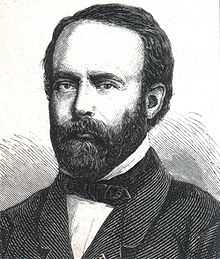Henri Étienne Sainte-Claire Deville
| Henri Sainte-Claire Deville | |
|---|---|
 | |
| Born |
11 March 1818 St Thomas, West Indies |
| Died |
1 July 1881 (aged 63) Boulogne-sur-Seine, France |
| Nationality | French |
| Institutions |
École Normale Sorbonne |
| Doctoral students | Louis Joseph Troost |
Henri Étienne Sainte-Claire Deville (11 March 1818 - 1 July 1881) was a French chemist.
He was born in the island of St Thomas, West Indies, where his father was French consul. Together with his elder brother Charles he was educated in Paris at the College Rollin. In 1844, having graduated as doctor of medicine and doctor of science, he was appointed to organize the new faculty of science at Besançon, where he acted as dean and professor of chemistry from 1845 to 1851. Returning to Paris in the latter year he succeeded Antoine Jérôme Balard at the École Normale, and in 1859 became professor at the Sorbonne in place of J. B. A. Dumas, for whom he had begun to lecture in 1853. He died at Boulogne-sur-Seine.
In 1841, he began his experiments with investigations of oil of turpentine and tolu balsam, in the course of which he discovered toluene. But his most important work was in inorganic and thermal chemistry. In 1849 he discovered anhydrous nitric acid (nitrogen pentoxide), a substance interesting as the first obtained of the so-called "anhydrides" of the monobasic acids. In 1855, ignorant of what Friedrich Wöhler had done ten years previously, he succeeded in obtaining metallic aluminium, and ultimately he devised a method by which the metal could be prepared on a large scale by the aid of sodium, the manufacture of which he also developed. Together with Friedrich Wöhler, he has discovered silicon nitride in 1857.[1] With Jules Henri Debray (1827–1888) he worked at the platinum metals, his object being on the one hand to prepare them pure, and on the other to find a suitable metal for the standard metre for the International Metric Commission then sitting at Paris. With Louis Joseph Troost (b. 1825) he devised a method for determining vapour densities at temperatures up to 1400˚C, and, partly with F. Wohler, he investigated the allotropic forms of silicon and boron. The artificial preparation of minerals, especially of apatite and isorhor-phous minerals and of crystalline oxides, was another subject in which he made many experiments. But his best known contribution to general chemistry is his work on the phenomena of reversible reactions, which he comprehended under a general theory of "dissociation." He first took up the subject about 1857, and it was in the course of his investigations on it that he devised the apparatus known as the "Deville hot and cold tube."
![]() This article incorporates text from a publication now in the public domain: Chisholm, Hugh, ed. (1911). Encyclopædia Britannica (11th ed.). Cambridge University Press.
This article incorporates text from a publication now in the public domain: Chisholm, Hugh, ed. (1911). Encyclopædia Britannica (11th ed.). Cambridge University Press.
References
- ↑ Deville, H. and Wohler, F. (1857). "Erstmalige Erwahnung von Si3N4". Liebigs Ann. Chem. 104: 256.
- Jaime Wisniak (2004). "Henri Étienne Sainte-Claire Deville: A physician turned metallurgist". Journal of Materials Engineering and Performance 13 (2): 117–128. Bibcode:2004JMEP...13..117W. doi:10.1361/10599490418271.
- A.G. Morachevskii (2006). "Henri Étienne Sainte-Claire Deville (to 150th anniversary of the development of the first industrial method for production of aluminum)". Russian Journal of Applied Chemistry 79 (10): 1731–1735. doi:10.1134/S1070427206100399.
|